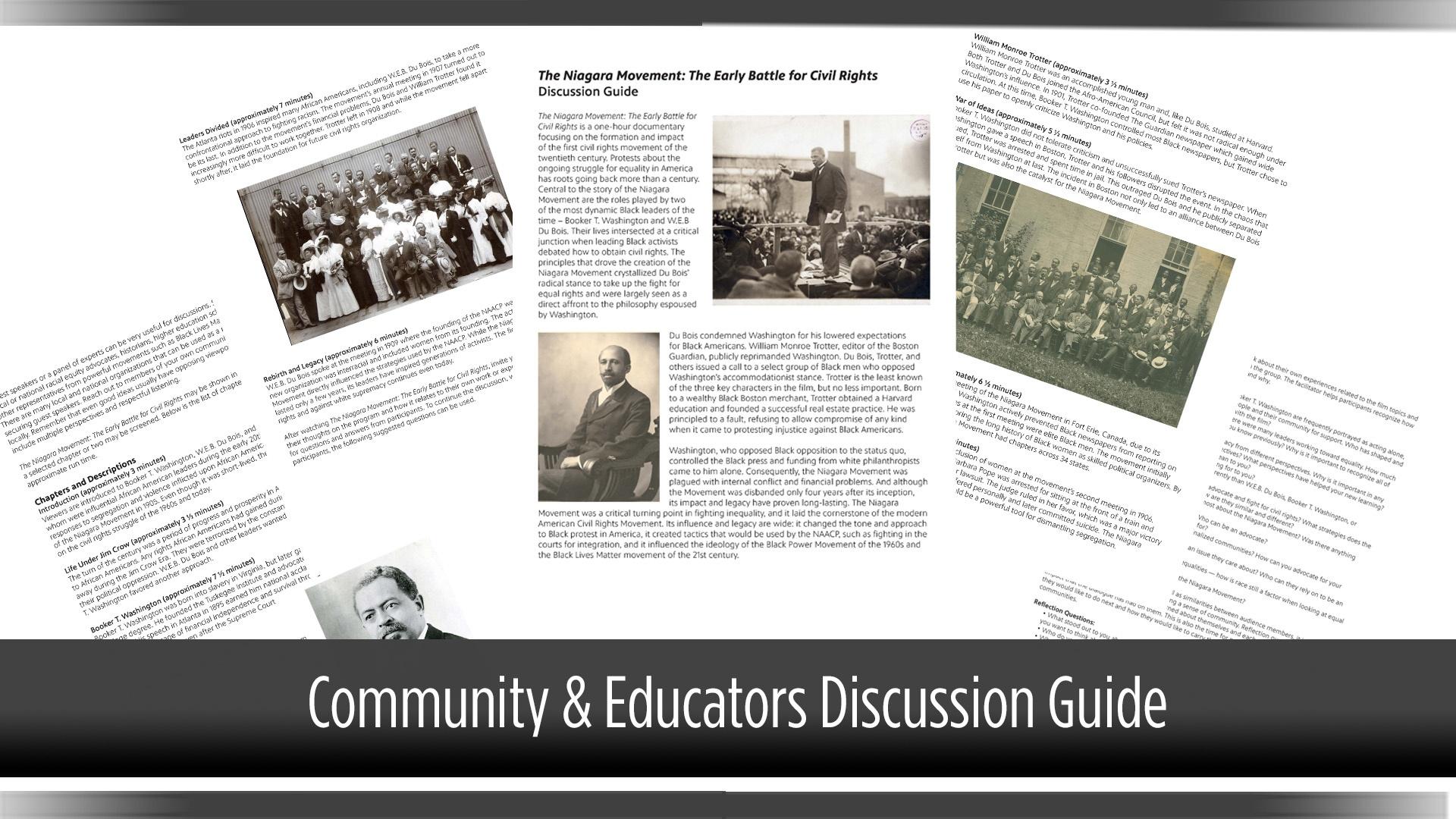Curriculum Resources
The Niagara Movement: The Early Battle for Civil Rights is a one-hour documentary focusing on the formation and impact of the first civil rights movement of the 20th century. The program explores the lives and political beliefs of three notable African American leaders from this era: Booker T. Washington, W.E.B. Du Bois, and William Monroe Trotter. More than a century later, activists are still demanding justice and a more equitable world. The program and its accompanying resources will help students look beyond the story of the movement’s formation to raise broader questions about how it relates to the struggles of Black America today.
Using these resources, educators and facilitators can effectively inform classrooms about this historic movement and how it relates to the struggles of Black America today. Conversations about where we have come from and where we go next can be had to continue the movement towards equity.
These lesson plans are designed for middle and high school students (grades 6-12) and meet National Curriculum Standards. Some of the themes covered are activism, ideology, the role of women, the Black Press, marginalization, the Jim Crow era, civil rights, and the legacy of the Niagara Movement.
All curriculum resources are available here on the program website and PBS LearningMedia, a free national platform that provides digital learning tools for K-12 classrooms. PBS LearningMedia has a national reach of 1.8 million educators, over 30 million students, and a digital library of more than 118,000 classroom-ready resources.
Explore the The Niagara Movement: The Early Battle for Civil Rights collection on PBS LearningMedia here.
Lesson Plans
Figures in the Forefront (Grades 6-8 )
Students define key terms related to the Niagara Movement. Learn about the early lives, education, and political careers of Booker T. Washington, W.E.B. Du Bois, and William Monroe Trotter. After watching, students discuss the similarities and differences between these three influential figures.
Hidden Heroines of Civil Rights (Grades 6-8)
Students unpack the conflict between W.E.B. Du Bois and William Monroe Trotter over the inclusion of women. The Niagara Movement initially excluded female members, ignoring the long history of black women as skilled political organizers. After watching, students research a women’s organization or a female activist that fought for civil rights in the early 20th century.
The Forgotten Story of Barbara Pope (Grades 9-12 )
Students discover the untold story of Barbara Pope, who was arrested in 1906 for sitting at the front of a train. The lawsuit that followed had a major impact on the Niagara Movement and later civil rights organizations. After watching, students conduct research about Pope’s life and legacy.
The Black Press (Grades 9-12)
Students learn about the role of the Black press in the development of the Niagara Movement. In the early 1900s, Booker T. Washington controlled most Black newspapers, but William Monroe Trotter used his paper to openly criticize Washington and his policies. After watching, students write an article to draw attention to an important issue, individual, or movement today.
Organizing Activism (Grades 9-12)
Students understand the historical context that led to the formation of the Niagara Movement in 1905. Even though it was short-lived, the movement had a major impact on the civil rights struggle of the 1960s and today. As you watch, analyze the ideologies and tactics of the Niagara Movement's leaders as well as its opponents.
Right Time, Right Place (Grades 9-12)
Students recognize the significance of the Jim Crow era, during which Black Americans were subject to political oppression and violence. These conditions directly led to the first meeting of the Niagara Movement, which was strategically held close to Buffalo, NY, in 1905. As you watch, identify the barriers to socio-political mobility of Black Americans as well as the forms of resistance and institutions that developed in response.
Rebirth and Legacy (Grades 6-8, 9-12)
Students reflect on the long-term impact of the Niagara Movement using the provided vocabulary and discussion guide. Its strategies directly influenced the NAACP and its leaders have inspired generations of activists. The fight for full citizenship rights and against white supremacy continues even today.
Community & Educators Discussion Guide
This guide provides suggestions for classrooms, schools, or community organizations to initiate discussion using The Niagara Movement: The Early Battle for Civil Rights. Questions are provided in the discussion guide as conversation starters. Ideas for local activism are included for use by classrooms and communities. Thoughts on how to connect to local and national organizations that move the idea of equity forward are also included.

